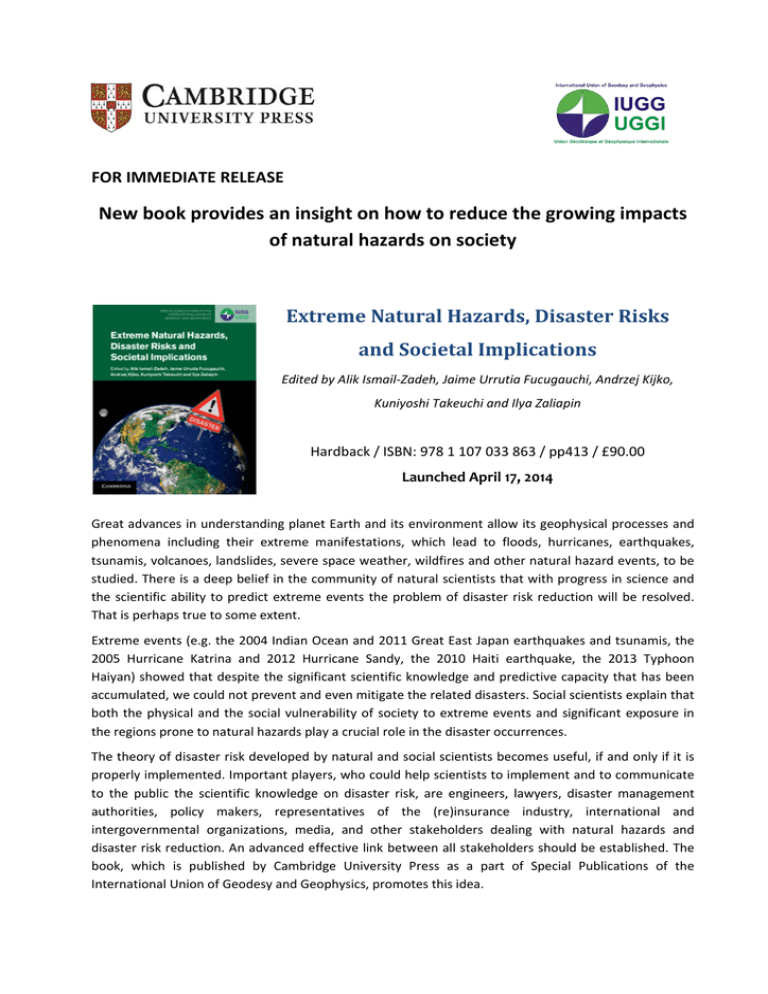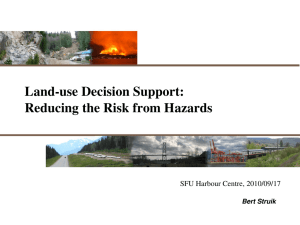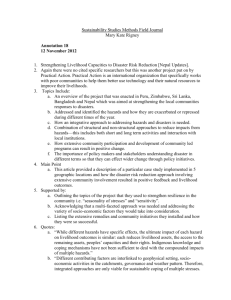New book provides an insight on how to reduce the growing impacts of natural hazards on society Extreme Natural Hazards, Disaster Risks
advertisement

FOR IMMEDIATE RELEASE New book provides an insight on how to reduce the growing impacts of natural hazards on society ExtremeNaturalHazards,DisasterRisks andSocietalImplications Edited by Alik Ismail‐Zadeh, Jaime Urrutia Fucugauchi, Andrzej Kijko, Kuniyoshi Takeuchi and Ilya Zaliapin Hardback / ISBN: 978 1 107 033 863 / pp413 / £90.00 Launched April 17, 2014 Great advances in understanding planet Earth and its environment allow its geophysical processes and phenomena including their extreme manifestations, which lead to floods, hurricanes, earthquakes, tsunamis, volcanoes, landslides, severe space weather, wildfires and other natural hazard events, to be studied. There is a deep belief in the community of natural scientists that with progress in science and the scientific ability to predict extreme events the problem of disaster risk reduction will be resolved. That is perhaps true to some extent. Extreme events (e.g. the 2004 Indian Ocean and 2011 Great East Japan earthquakes and tsunamis, the 2005 Hurricane Katrina and 2012 Hurricane Sandy, the 2010 Haiti earthquake, the 2013 Typhoon Haiyan) showed that despite the significant scientific knowledge and predictive capacity that has been accumulated, we could not prevent and even mitigate the related disasters. Social scientists explain that both the physical and the social vulnerability of society to extreme events and significant exposure in the regions prone to natural hazards play a crucial role in the disaster occurrences. The theory of disaster risk developed by natural and social scientists becomes useful, if and only if it is properly implemented. Important players, who could help scientists to implement and to communicate to the public the scientific knowledge on disaster risk, are engineers, lawyers, disaster management authorities, policy makers, representatives of the (re)insurance industry, international and intergovernmental organizations, media, and other stakeholders dealing with natural hazards and disaster risk reduction. An advanced effective link between all stakeholders should be established. The book, which is published by Cambridge University Press as a part of Special Publications of the International Union of Geodesy and Geophysics, promotes this idea. Book editor, Alik Ismail‐Zadeh said: “Extreme Natural Hazards, Disaster Risks and Societal Implications is intended to bridge two major themes, natural hazards and disaster risks, and presents the ways in which scientific knowledge could help to reduce risks of disasters for the benefit of society. The book summarizes the major topics discussed at the scientific meetings held in the framework of the trans‐ disciplinary, international project “Extreme Natural Events and Societal Implications ‐ ENHANS” (http://www.enhans.org) co‐sponsored by the International Council for Science (ICSU), several international and intergovernmental organizations”. Now, this book presents a unique, interdisciplinary approach to disaster risk research, combining cutting‐edge natural science and social science methodologies. Bringing together leading scientists, policy makers, and practitioners from around the world, the book presents the risks of global hazards and provides real world hazard case studies from Latin America, the Caribbean, Africa, the Middle East, Asia and the Pacific region. The authors provide insight into topics such as extreme natural hazards, the vulnerability of society, disaster risk reduction policy, relations between disaster policy and climate change, adaptation to hazards, and (re)insurance approaches to extreme events. This is a key resource for academic researchers and graduate students in a wide range of disciplines linked to hazard and risk studies, including seismology, volcanology, hydrology, meteorology, geomorphology, geomagnetism, oceanography, remote sensing, engineering, and geography. It is also an important reference for professionals and policy makers working in disaster prevention and mitigation. About the editors Alik Ismail‐Zadeh is Senior Scientist at the Karlsruhe Institute of Technology, Karlsruhe, Germany and Chief Scientist at the Russian Academy of Sciences, Moscow, Russia. His scientific interests cover studies of dynamics of the lithosphere and upper mantle and their surface manifestations including seismicity, seismic hazard, and risk. He has served as President of the Natural Hazards Focus Group of the American Geophysical Union (AGU), President of the IUGG Union Commission of Geophysical Risk and Sustainability, and the leader of the ENHANS project. Jaime Urrutia Fucugauchi is Professor of Geophysics at Instituto de Geofisica, Universidad Nacional Autonoma de Mexico (UNAM), and is a leading expert in geomagnetism and volcanism. He is President of the Mexican Physics Society and a member of the Governing Board of the American Institute of Physics, and the Science Advisory Council of Mexico. Andrzej Kijko is the Director of the University of Pretoria Natural Hazards Centre, Pretoria, South Africa, and also a Professor of the University of Pretoria. As an internationally acclaimed researcher, he has been active in engineering geophysics and seismology for about 40 years. Kuniyoshi Takeuchi is the founding Director of the International Centre for Water Hazard and Risk Management (ICHARM) in Tsukuba, and is also Professor Emeritus of the University of Yamanashi in Kofu, Japan. He is a hydrologist whose research interests cover modeling and forecasting, water resource systems analysis, flood and disaster management, and societal sustainability issues. Takeuchi is Chair of the IUGG GeoRisk Commission and Vice Chair of the Scientific Committee of the Program ‘Integrated Research on Disaster Risk’ (IRDR). Ilya Zaliapin is Associate Professor of the Department of Mathematics and Statistics, University of Nevada, Reno, USA. His broad research interests cover problems of self‐similarity, network transport, multi‐scale methods of time series analysis, random sums of heavy tailed variables, geo‐statistics, extreme value theory with applications to atmospheric, hydrological and seismological research. Contributors Gordon McBean, Amy Donovan, Clive Oppenheimer, Irasema Alcántara‐Ayala, Alik Ismail‐Zadeh, Akio Kitoh, Ning Lin, Kerry Emanuel, Erik Vanmarcke, Soroosh Sorooshian, Phu Nguyen, Scott Sellars, Dan Braithwaite, Amir AghaKouchak, Kuolin Hsu, Daniel N. Baker, Jamie M. Jackson, Lauren K. Thompson, Andrei Gabrielov, Vladimir Keilis‐Borok, Sayaka Olsen, Ilya Zaliapin, Omar J. Pérez, Carlos Rodríguez, José L. Alonso, Jaime Urrutia‐Fucugauchi, Nils Lenhardt, Gezahegn Yirgu, David J. Ferguson, Talfan D. Barnie, Vunganai Midzi, Brassnavy Manzunzu, Vyacheslav K. Gusiakov, Mahefasoa T. Randrianalijaona, Ailsa Holloway, Abdulaziz M. Al‐Bassam, Faisal K. Zaidi, Mohammad T. Hussein, Gerassimos A. Papadopoulos, Antonia Papageorgiou, Mohsen Ghafory‐Ashtiany, Sucharit Koontanakulvong, Tom Beer, Zhongliang Wu, Tengfei Ma, Kenji Satake, T. Srinivasa Kumar, Shailesh Nayak, Harsh K. Gupta, Sálvano Briceño, Stephen Dovers, John Handmer, Keith Alverson, Anselm Smolka, Angelika Wirtz, Petra Löw, Thomas Mahl, Sibel Yildirim For further information, please visit: www.cambridge.org/9781107033863 About International Union of Geodesy and Geophysics IUGG is a non‐governmental, international, scientific organization dedicated to advancing, promoting, and communicating knowledge of the Earth system, its space environment, and the dynamical processes causing change. IUGG is comprised of eight International Associations dealing with cryospheric sciences, geodesy, geomagnetism and aeronomy, hydrology, meteorology and atmospheric sciences, oceanography, seismology, volcanology, physics and chemistry of the Earth’s interior, solar‐terrestrial relations, and analogous problems associated with the Moon and other planets. IUGG encourages the application of this knowledge to societal needs, such as mineral resources, mitigation of natural hazards, climate change, and environmental preservation. About Cambridge University Press Cambridge University Press is the publishing business of the University of Cambridge. Dedicated to excellence, its purpose is to further the University's objective of advancing knowledge, education, learning, and research. Its extensive peer‐reviewed publishing lists comprise 45,000 titles covering academic research, professional development, over 300 research journals, school‐level education, English language teaching and bible publishing. Playing a leading role in today's international market place, Cambridge University Press has over 50 offices around the globe, and it distributes its products to nearly every country in the world. MEDIA INFORMATION Editor of the book, Alik Ismail‐Zadeh, is available for interview. He can be contacted by e‐mail: Alik.Ismail‐Zadeh@kit.edu or on the phone+49 (0)721 6084 4610.




